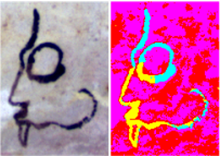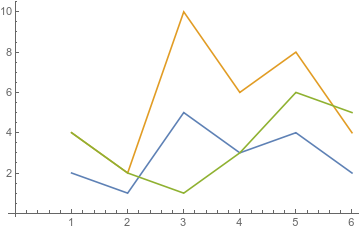


You can access this page from the homepage in I-Learn.
Pre-Class Chatter
Feel free to turn on your mic and chat with people or use the zoom chat. Or chat with your group in your Jamboard.
9:00 AM Jamboard Links
| G1 | G2 | G3 | G4 | G5 | G6 | G7 |
|
|
|
|
|
|
|
12:45 PM Jamboard Links
| G1 | G2 | G3 | G4 | G5 | G6 |
|
|
|
|
|
|
Fang Face - 6D angle between vectors
How can we determine if cave markings on a wall were made with different materials?

The image in the cave looks all black to the human eye. However, lots of materials look black when used. These cave markings, detailing a map of the surrounding area, could have been made all at once, or by different groups of people as more information was learned. Is there a way to determine if the materials used to make the map are all the same?
We use cameras designed to capture wave lengths that we can't see, and take 6 different snap shots (capturing different types of information). For each pixel in the picture, the cameras record six numbers. We can think of these numbers as a 6D vectors, such as the 3 simplified vectors below.
- $\vec v_1 = (2, 1, 5, 3, 4, 2)$
- $\vec v_2 = (4, 2, 10, 6, 8, 4)$
- $\vec v_3 = (4, 2, 1, 3, 6, 5)$

How do we recognize if two vectors represent the same material? First, the numbers can increase proportionally with brightness. Double the brightness, and the numbers coming back can double. So the same material may register as different vectors.
- Can you tell that $v_2$ is twice $\vec v_1$?
We can use the law of cosines $$\vec u\cdot\vec v = |\vec u||\vec v|\cos\theta$$ to compute the angle between each six dimensional vector. The engineering team which worked on this project used a method called $k$-means clustering to group vectors together based off these angles, and determined that several different materials were used.
Rapid Recall
- I'll draw two vectors $\vec F$ and $\vec d$. Draw the projection of $\vec F$ onto $\vec d$ (i.e. $\text{proj}_{\vec d}\vec F$).
Solution
We'll do this one together, and look at a visual solution using Mathematica and a file from I-Learn 215-Tech-Introduction.nb.
- When we write the sum $\vec F = \vec F_{\parallel \vec d}+ \vec F_{\perp \vec d}$, we call $\vec F_{\parallel \vec d}$ the ____ of $\vec F$ that is ____ to $\vec d$.
Solution
The (vector) component of $\vec F$ that is parallel to $\vec d$. Note that this vector is just the projection of $\vec F$ onto $\vec d$, so $\text{proj}_{\vec d}\vec F$.
The length of this vector is sometimes called the scalar component of $\vec F$ that is parallel to $\vec d$.
- What do we call $\vec F_{\perp \vec d}$.
Solution
The vector component of $\vec F$ that is orthogonal to $\vec d$.
- If $\vec F=(6,7)$ and $\vec F_{\parallel \vec d} = (2,-1)$, then what is $\vec F_{\perp \vec d}$?
Solution
Since $\vec F_{\parallel \vec d}$ and $\vec F_{\perp \vec d}$ must sum to $\vec F$, then $\vec F_{\perp \vec d} = \vec F - \vec F_{\parallel \vec d} = (6,7)-(2,-1) = (4,8)$.
Note that $\vec F_{\parallel \vec d} \cdot \vec F_{\perp \vec d}=0$, which should be the case (these two vectors are always orthogonal).
- If a force $\vec F$ of magnitude 10 N acts in the same direction as a displacement $\vec d$ of 5 m, what is the work done by $\vec F$ through the displacement $\vec d$?
Solution
The work done by $\vec F$ through $\vec d$ is the dot product $$\vec F\cdot \vec d = |\vec F||\vec d|\cos\theta = (10 N)(5 m)\cos 0 = 50 Nm.$$ This is one of the key application of the dot product.
Note that when the direction of the force and displacement are the same, then $\cos \theta = 1$, which gives the work as simply $W = |\vec F||\vec d|$. This is the most common introductory explanation in a physics course. In general, we have $$W = |\vec F||\vec d|\cos \theta = \vec F\cdot \vec d.$$ The dot product was created around 1900, with one benefit being that it simplifies work computations, precisely when the force and displacement are NOT in the same direction.
- The force $\vec F = (3,5)$ N acts on an object which undergoes a displacement $(-2,1)$ m. Find the work done by $\vec F$ though this displacement.
Solution
Work is given as the dot product of $\vec F$ and $\vec d$. Thus, $W=(3,5)\cdot(-2,1)=-6+5=1$ Nm .
Group problems
- Ben - Remember to send everyone a link to this page in chat.
- In BreakOut rooms - Take turns writing on your Jamboard. Give everyone a chance to be the scribe. The point is to discuss the problems below, and help one another.
Let $\vec F=(-10,0)$ N and $\vec d=(2,1)$ m. Recall the projection of $\vec F$ onto $\vec d$ is $\ds \text{proj}_\vec d\vec F = \frac{\vec F\cdot \vec d}{\vec d\cdot \vec d}\vec d$.
- How much work is done by $\vec F$ through the displacement $\vec d$? (Yes, just compute the dot product of the two vectors).
- Compute the projection of $\vec F$ onto $\vec d$ (so compute $\vec F_{\parallel \vec d}$).
- Draw $\vec F$, $\vec d$ and $\text{proj}_\vec d\vec F $ on the same grid, all with their base at the origin. Try your best to give the $x$ and $y$ directions the same scale, otherwise you won't be able to see the connections among vectors.
- Add to your picture the vector difference $\vec F_{\perp \vec d}=\vec F - \text{proj}_\vec d\vec F $. Which vectors in your picture are orthogonal?
- Draw $\text{proj}_\vec F\vec d $, without doing any computations. Have each group member do this, and discuss any differences.
- Draw the vector field $\vec F(x,y) = \langle2x+y,x+2y\rangle$. (Based at $(x,y)$, draw the vector $\langle2x+y,x+2y\rangle$.)
- Draw the vector field $\vec F(x,y) = \langle y,-x\rangle$.
|
Sun |
Mon |
Tue |
Wed |
Thu |
Fri |
Sat |
